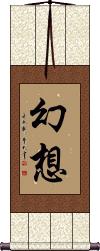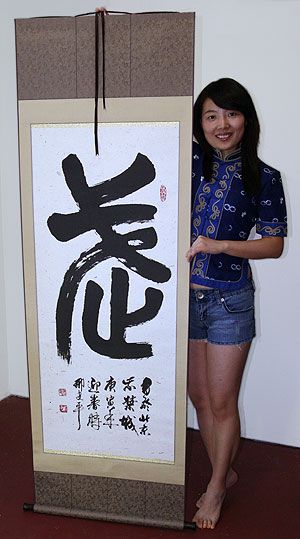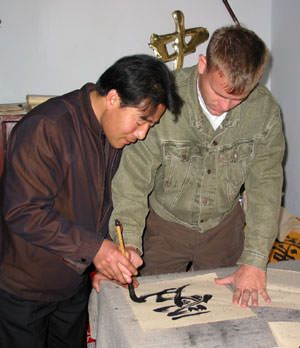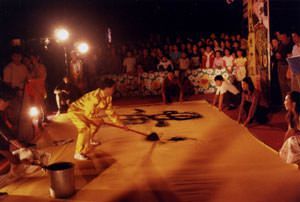Many custom options...
And formats...

Delusion in Chinese / Japanese...
Buy a Delusion calligraphy wall scroll here!
Fantasy / Illusion
幻想 is illusions or fantasy in Chinese, Japanese Kanji, and old Korean Hanja.
This can also refer to delusion or daydreaming. It sort of means a dream or idea that cannot be true or real ( at least not in this realm).
Not the results for delusion that you were looking for?
Below are some entries from our dictionary that may match your delusion search...
| Characters If shown, 2nd row is Simp. Chinese |
Pronunciation Romanization |
Simple Dictionary Definition |
迷 see styles |
mí mi2 mi mei |
More info & calligraphy: Lost / Dazed and Confusedmāyā; delude, deceive, confuse, mislead; delusion, illusion, etc. |
道 see styles |
dào dao4 tao dou / do どう |
More info & calligraphy: Daoism / Taoism(1) (abbreviation) (See 道・みち・1) road; path; street; route; (2) (See 道・みち・5) way; set of practices; rules for conducting oneself; (3) (abbreviation) (in Japanese schools) (See 道徳教育) moral education; (4) Buddhist teachings; (5) Taoism; (6) administrative region of Japan (Hokkaido); (7) (hist) administrative region of Japan (Tokaido, Tosando, etc.); (8) province (administrative region of Korea); (9) circuit (administrative region of China); (10) (hist) province (Tang-era administrative region of China); (personal name) Wataru mārga. A way, road; the right path; principle, Truth, Reason, Logos, Cosmic energy; to lead; to say. The way of transmigration by which one arrives at a good or bad existence; any of the six gati, or paths of destiny. The way of bodhi, or enlightenment leading to nirvāṇa through spiritual stages. Essential nirvāṇa, in which absolute freedom reigns. For the eightfold noble path v. 八聖道.; The two Ways: (1) (a) 無礙道 or 無間道 The open or unhindered way, or the way of removing all obstacles or intervention, i. e. all delusion; (b) 解脫道 the way of release, by realization of truth. (2) (a) 難行道 The hard way of "works", i. e. by the six pāramitā and the disciplines. (b) 易行道 the easy way salvation, by the invocation of Amitābha. (3) (a) 有漏道 The way of reincarnation or mortality; (b) 無漏 the enlightened way of escape from the miseries of transmigration. (4) (a) 教道 The way of instruction; (b) 證道 the way of realization. (5) The two lower excretory organs. |
五行 see styles |
wǔ xíng wu3 xing2 wu hsing gogyou / gogyo ごぎょう |
More info & calligraphy: Five Elements(1) (See 五大・ごだい・1) the five elements (in Chinese philosophy: wood, fire, earth, metal and water); the five phases; wu xing; (2) {Buddh} five practices of the Bodhisattvas; (3) (See 六信五行) the five pillars of Islam; (surname, given name) Gogyou The five lines of conduct. I. According to the 起信論 Awakening of Faith they are almsgiving; keeping the commandments; patience under insult; zeal or progress; meditation. II. According to the 涅槃經 Nirvana Sutra they are saintly or bodhisattva deeds; arhat, or noble deeds; deva deeds; children's deeds (i. e. normal good deeds of men, devas, and Hinayanists); sickness conditions, e. g. illness, delusion, etc.; — into all these lines of conduct and conditions a Bodhisattva enters. III. The five elements, or tanmātra— wood, fire, earth, metal, and water; or earth, water, ire, air, and ether (or space) as taught by the later Mahāyāna philosophy; idem 五大. |
八正道 see styles |
bā zhèng dào ba1 zheng4 dao4 pa cheng tao hasshōdō はっしょうどう |
More info & calligraphy: The Noble Eightfold Path(Buddhist term) noble eightfold path (八正道分) Āryamārga. The eight right or correct ways, the "eightfold noble path" for the arhat to nirvāṇa; also styled 八道船, 八正門, 八由行, 八游行, 八聖道支, 八道行, 八直行, 八直道. The eight are: (1) 正見Samyag-dṛṣṭi, correct views in regard to the Four Axioms, and freedom from the common delusion. (2) 正思 Samyak-saṁkalpa, correct thought and purpose. (3) 正語 Samyag-vāc, correct speech, avoidance of false and idle talk. (4) 正業 Samyak-karmānta, correct deed, or conduct, getting rid of all improper action so as to dwell in purity. (5) 正命 Smnyag-ājīva, correct livelihood or occupation, avoiding the five immoral occupations. (6) 正精進 Samyag-vyāyāma, correct zeal, or energy in uninterrupted progress in the way of nirvāṇa. (7) 正念 Samyak-smṛti, correct remembrance, or memory, which retains the true and excludes the false. (8) 正定 Samyak-samadhi, correct meditation, absorption, or abstraction. The 正 means of course Buddhist orthodoxy, anything contrary to this being 邪 or heterodox, and wrong. |
伏 see styles |
fú fu2 fu fuse ふせ |
to lean over; to fall (go down); to hide (in ambush); to conceal oneself; to lie low; hottest days of summer; to submit; to concede defeat; to overcome; to subdue; volt (surname) Fuse Prostrate; humble; suffer, bear; ambush; dog-days; hatch; it is used for control, under control, e. g. as delusion; 斷 is contrasted with it as complete extirpation, so that no delusive thought arises. |
使 see styles |
shǐ shi3 shih shi し |
to make; to cause; to enable; to use; to employ; to send; to instruct sb to do something; envoy; messenger (1) messenger; (2) (abbreviation) (See 検非違使) police and judicial chief (Heian and Kamakura periods); (3) {Buddh} (See 煩悩・2) klesha (polluting thoughts such as greed, hatred and delusion, which result in suffering); (female given name) Tsukasa To send; cause; a messenger; a pursuer, molester, lictor, disturber, troubler, intp. as 煩惱 kleśa, affliction, distress, worldly cares, vexations, and as consequent reincarnation. There are categories of 10, 16, 98, 112, and 128 such troublers, e. g. desire, hate, stupor, pride, doubt, erroneous views, etc., leading to painful results in future rebirths, for they are karma-messengers executing its purpose. Also 金剛童子 q. v. |
垢 see styles |
gòu gou4 kou ku く |
dirt; disgrace {Buddh} (See 煩悩・2) klesha (polluting thoughts such as greed, hatred and delusion, which result in suffering); (personal name) Yoshimi mala. Dust, impurity, dregs; moral impurity; mental impurity. Whatever misleads or deludes the mind; illusion; defilement; the six forms are vexation, malevolence, hatred, flattery, wild talk, pride; the seven are desire, false views, doubt, presumption, arrogance, inertia, and meanness. |
惑 see styles |
huò huo4 huo waku わく |
to confuse; to be puzzled {Buddh} (See 煩悩・ぼんのう・2) klesha; (given name) Waku moha. Illusion, delusion, doubt, unbelief; it is also used for kleśa, passion, temptation, distress, care, trouble. |
痴 see styles |
chī chi1 ch`ih chih chi ち oko おこ |
imbecile; sentimental; stupid; foolish; silly (1) foolishness; fool; (2) (Buddhist term) moha (ignorance, folly); (noun or adjectival noun) foolish thing; stupid thing; absurdity moha, 'unconsciousness,' 'delusion,' 'perplexity,' 'ignorance, folly,' 'infatuation,' etc. M.W. Also, mūḍha. In Chinese it is silly, foolish, daft, stupid. It is intp. by 無明 unenlightened, i.e. misled by appearances, taking the seeming for real; from this unenlightened condition arises every kind of kleśa, i.e. affliction or defilement by the passions, etc. It is one of the three poisons, desire, dislike, delusion. |
癡 痴 see styles |
chī chi1 ch`ih chih chi ち |
variant of 痴[chi1] (out-dated kanji) (1) foolishness; fool; (2) (Buddhist term) moha (ignorance, folly) v. 痴 13. |
通 see styles |
tòng tong4 t`ung tung tsuu / tsu つう |
classifier for an activity, taken in its entirety (tirade of abuse, stint of music playing, bout of drinking etc) (n,n-suf,adj-na) (1) authority; expert; connoisseur; well-informed person; (counter) (2) counter for messages, letters, notes, documents, etc.; (noun or adjectival noun) (3) understanding (esp. of male-female relations); tact; insight; (4) supernatural powers; magical powers; (given name) Michiaki Permeate, pass through, pervade; perceive, know thoroughly; communicate; current; free, without hindrance, unimpeded universal; e.g. 神通 supernatural, ubiquitous powers. There are categories of 五通, 六通, and 十通, all referring to supernatural powers; the five are (1) knowledge of the supernatural world; (2) deva vision; (3) deva hearing; (4) knowledge of the minds of all others; (5) knowledge of all the transmigrations of self and all others. The six are the above together with perfect wisdom for ending moral hindrance and delusion. The ten are knowing all previous transmigrations, having deva hearing, knowing the minds of others, having deva vision, showing deva powers, manifesting many bodies or forms, being anywhere instantly, power of bringing glory to one's domain, manifesting a body of transformation, and power to end evil and transmigration. |
障 see styles |
zhàng zhang4 chang shō |
to block; to hinder; to obstruct varaṇa; āvaraṇa; a screen, barricade, partition, a term for the passions or any delusion which hinders enlightenment. |
三斷 三断 see styles |
sān duàn san1 duan4 san tuan sandan |
The three cuttings off or excisions (of 惑 beguiling delusions, or perplexities). (1) (a) 見所斷 to cut off delusions of view, of which Hīnayāna has eighty-eight kinds; (b) 修所斷in practice, eighty-one kinds; (c) 非所斷nothing left to cut off, perfect. v. 倶舍論 2. (2) (a) 自性斷 to cut off the nature or root (of delusion); (b) 緣縛斷 to cut off the external bonds, or objective causes (of delusions); (c) 不生斷 (delusion) no longer arising, therefore nothing produced to cut off. The third stage in both groups is that of an arhat. |
三術 三术 see styles |
sān shù san1 shu4 san shu sanjutsu |
Three devices in meditation for getting rid of Māra-hindrances: within, to get rid of passion and delusion; without, to refuse or to withdraw from external temptation. |
不二 see styles |
bù èr bu4 er4 pu erh funi ふに |
the only (choice, way etc); undivided (loyalty) {Buddh} advaitam (non-duality); (surname, female given name) Fuji advaya. No second, non-duality, the one and undivided, the unity of all things, the one reality、 the universal Buddha-nature. There are numerous combinations, e. g. 善惡不二 good and evil are not a dualism: nor are 有 and 空 the material and immaterial, nor are 迷 and 悟 delusion and awareness— all these are of the one Buddha-nature. |
九惑 see styles |
jiǔ huò jiu3 huo4 chiu huo ku waku |
nine kinds of delusion |
二障 see styles |
èr zhàng er4 zhang4 erh chang nishō |
The two hindrances:(1) (a) 煩惱障 The passions and delusion which aid rebirth and hinder entrance into nirvana; (b) 智障 or所知障, worldly wisdom e.g. accounting the seeming as real, a hindrance to true wisdom. (2) (a) 煩惱障 as above; (b) 解脱障 hindrances to deliverance. (3) (a)理障 hindrances to truth; (b) 事障 hindrances of the passions, etc. |
五力 see styles |
wǔ lì wu3 li4 wu li goriki |
pañcabalāni, the five powers or faculties — one of the categories of the thirty-seven bodhipakṣika dharma 三十七助道品; they destroy the 五障 five obstacles, each by each, and are: 信力 śraddhābala, faith (destroying doubt); 精進力 vīryabala, zeal (destroying remissness); 念 or 勤念 smṛtibala, memory or thought (destroying falsity); 正定力 samādhibala, concentration of mind, or meditation (destroying confused or wandering thoughts); and 慧力 prajñābala, wisdom (destroying all illusion and delusion). Also the five transcendent powers, i. e. 定力 the power of meditation; 通力 the resulting supernatural powers; 借識力 adaptability, or powers of 'borrowing' or evolving any required organ of sense, or knowledge, i. e. by beings above the second dhyāna heavens; 大願力 the power of accomplishing a vow by a Buddha or bodhisattva; and 法威德力 the august power of Dharma. Also, the five kinds of Mara powers exerted on sight, 五大明王. |
五因 see styles |
wǔ yīn wu3 yin1 wu yin goin |
The five causes, v. 倶舍論 7. i. e. (1) 生因 producing cause; (2) 依因supporting cause; (3) 立因 upholding or establishing cause; (4) 持因 maintaining cause; (5) 養因 nourishing or strengthening cause. These all refer to the four elements, earth, water, fire, wind, for they are the causers or producers and maintainers of the infinite forms of nature. Another list from the Nirvana-Sutra 21 is (1) 生因 cause of rebirth, i. e. previous delusion; (2) 和合因 intermingling cause, i. e. good with good, bad with bad, neutral with neutral; (3) 住因 cause of abiding in the present condition, i. e. the self in its attachments; (4) 增長因 causes of development, e. g. food, clothing, etc.; (5) 遠因 remoter cause, the parental seed. |
佛滅 佛灭 see styles |
fó miè fo2 mie4 fo mieh butsumetsu |
(佛滅度) Buddha's nirvana; it is interpreted as the extinction of suffering, or delusion, and as transport across the 苦海 bitter sea of mortality, v. 滅. |
八法 see styles |
bā fǎ ba1 fa3 pa fa happō |
eight methods of treatment (TCM) The eight dharmas, things, or methods. There are three groups: (1) idem 八風 q.v. (2) 四大and 四微 q.v. (3) The eight essential things, i.e. 教 instruction, 理 doctrine, 智 knowledge or wisdom attained, 斷 cutting away of delusion, 行 practice of the religious life, 位 progressive status, 因 producing 果 the fruit of saintliness. Of these 教理行果 are known as the 四法. |
六因 see styles |
liù yīn liu4 yin1 liu yin rokuin |
The six causations of the 六位 six stages of Bodhisattva development, q. v. Also, the sixfold division of causes of the Vaibhāṣikas (cf. Keith, 177-8); every phenomenon depends upon the union of 因 primary cause and 緣 conditional or environmental cause; and of the 因 there are six kinds: (1) 能作因 karaṇahetu, effective causes of two kinds: 與力因 empowering cause, as the earth empowers plant growth, and 不障因 non-resistant cause, as space does not resist, i. e. active and passive causes; (2) 倶有因 sahabhūhetu, co-operative causes, as the four elements 四大 in nature, not one of which can be omitted; (3) 同類因 sabhāgahetu, causes of the same kind as the effect, good producing good, etc.; (4) 相應因 saṃprayuktahetu, mutual responsive or associated causes, e. g. mind and mental conditions, subject with object; Keith gives 'faith and intelligence'; similar to (2); (5) 遍行因 sarvatragahetu, universal or omnipresent cause, i. e. of illusion, as of false views affecting every act; it resembles (3) but is confined to delusion; (6) 異熟因 vipākahetu, differental fruition, i. e. the effect different from the cause, as the hells are from evil deeds. |
出塵 出尘 see styles |
chū chén chu1 chen2 ch`u ch`en chu chen shutsu jin |
To leave the dusty world of passion and delusion. |
化轉 化转 see styles |
huà zhuǎn hua4 zhuan3 hua chuan keten |
To transform, convert (from evil to good, delusion to deliverance). |
十境 see styles |
shí jìng shi2 jing4 shih ching jikkyō |
Ten objects of or stages in meditation觀 in the Tiantai school, i.e. 陰境 the five skandhas; 煩惱境 life's distresses and delusion; 病患境 sickness, or duḥkha, its cause and cure; 業相境 age-long karmaic influences; 魔事境 Māra affairs, how to overthrow their rule; 禪定境 the conditions of dhyāna and samādhi; 諸見境 various views and doubts that arise; 慢境 pride in progress and the delusion that one has attained nirvāṇa; 二乘境 temptation to be content with the lower nirvāṇa, instead of going on to the greater reward; 菩薩境 bodhisattvahood; see the 止觀 5. |
名相 see styles |
míng xiàng ming2 xiang4 ming hsiang myōsō |
famous prime minister (in ancient China); names and appearances (Buddhism) Name and appearance; everything has a name, e. g. sound, or has appearance, i. e. the visible, v. 名色; both are unreal and give rise to delusion. The name under which Subhūti will be reborn as Buddha. |
四怨 see styles |
sì yuàn si4 yuan4 ssu yüan shion |
The four enemies— the passions-and-delusion māras, death māra, the five-skandhas māras, and the supreme māra-king. |
四戒 see styles |
sì jiè si4 jie4 ssu chieh shikai |
Four stages in moral development: that of release, or deliverance from the world on becoming a monk; that arising from the four meditations on the realms of form; that above the stage of 見道 q. v.; that in which all moral evil is ended and delusion ceases. |
四道 see styles |
sì dào si4 dao4 ssu tao shimichi しみち |
(surname) Shimichi The Dao or road means the nirvana road; the 'four' are rather modes of progress, or stages in it: (1) 加行道 discipline or effort, i. e. progress from the 三賢 and 四善根 stages to that of the 三學位, i. e. morality, meditation, and understanding; (2) 無間道 uninterrupted progress to the stage in which all delusion is banished; (3) 解脫道 liberaton, or freedom, reaching the state of assurance or proof and knowledge of the truth; and (4) 勝進道 surpassing progress in dhyāni-wisdom. Those four stages are also associated with those of srota-āpanna, sakṛdāgāmin, anāgāmin, and arhat. |
執見 执见 see styles |
zhí jiàn zhi2 jian4 chih chien azami あざみ |
(surname) Azami Views obstinately held, with consequent delusion; bigoted. |
Click here for more delusion results from our dictionary
The following table may be helpful for those studying Chinese or Japanese...
| Title | Characters | Romaji (Romanized Japanese) | Various forms of Romanized Chinese | |
| Fantasy Illusion | 幻想 | gensou / genso | huàn xiǎng huan4 xiang3 huan xiang huanxiang | huan hsiang huanhsiang |
Successful Chinese Character and Japanese Kanji calligraphy searches within the last few hours...




